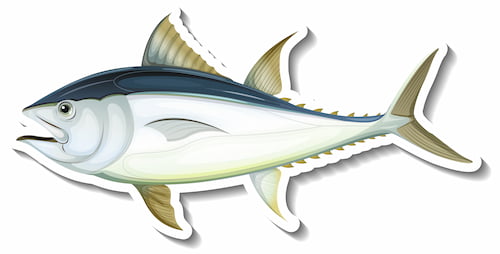High Protein Content: Tuna is rich in protein, which is essential for muscle growth, repair, and overall bodily function. It's a great option for those looking to increase their protein intake, especially for athletes and individuals engaged in regular physical activity.
Rich in Omega-3 Fatty Acids: Tuna contains omega-3 fatty acids, particularly EPA (eicosapentaenoic acid) and DHA (docosahexaenoic acid), which are crucial for heart health. These fatty acids have been linked to reducing inflammation, lowering blood pressure, and improving cholesterol levels.
Source of Essential Nutrients: Tuna is packed with essential vitamins and minerals such as vitamin D, vitamin B12, selenium, and iodine. These nutrients play various roles in supporting overall health, including immune function, thyroid health, and nervous system function.
Low in Calories: Tuna is relatively low in calories compared to its high nutritional value, making it a suitable option for those looking to manage their weight or reduce calorie intake.
Versatility: Tuna can be prepared in numerous ways, including grilling, baking, or incorporating into salads and sandwiches. Its versatility makes it easy to include in a variety of dishes, catering to different tastes and dietary preferences.
Convenience: Canned tuna is readily available in most grocery stores and has a long shelf life, making it a convenient option for quick and easy meals, especially for those with busy lifestyles.
Sustainable Option: When sourced sustainably, tuna can be an environmentally friendly choice. Opting for tuna that is responsibly caught or certified by organizations like the Marine Stewardship Council (MSC) ensures that you're supporting sustainable fishing practices.

Grilled or Baked: Grilling or baking tuna steaks is a popular method that helps retain its natural flavors and nutrients. Season the tuna with herbs, spices, or a marinade of your choice before cooking for added flavor.
Pan-Seared: Pan-searing tuna is another quick and easy way to enjoy it. Heat a skillet over medium-high heat, add a small amount of oil, and sear the tuna for a few minutes on each side until it's cooked to your desired level of doneness.
Raw: Tuna is a staple in dishes like sushi and sashimi. When consuming raw tuna, it's crucial to ensure that it's fresh and sourced from reputable suppliers to minimize the risk of foodborne illness.
Canned: Canned tuna is a convenient option for adding protein to salads, sandwiches, wraps, pasta dishes, and more. It's versatile and can be easily incorporated into various recipes.
Salads: Tuna salad is a classic dish made by mixing canned tuna with mayonnaise, chopped vegetables, herbs, and seasonings. It can be enjoyed on its own, as a sandwich filling, or served over greens for a nutritious meal.
Tuna Casseroles: Tuna can be added to casseroles, pasta dishes, and rice-based dishes for a hearty and satisfying meal. Combine it with vegetables, cheese, and your favorite sauce for a comforting dish.
Tuna Steaks: Tuna steaks can be marinated and grilled, pan-seared, or broiled for a delicious and healthy main course. Serve them with a side of vegetables, rice, or potatoes for a complete meal.
Tuna is a healthy food rich in protein and omega-3 fatty acids, but like any food, it should be consumed in moderation. The recommended frequency of consumption depends on factors such as overall health, age, gender, and the amount of other nutrients consumed alongside it.
Generally, organizations like the American Heart Association recommend consuming fish, including tuna, at least twice a week as part of a balanced diet. However, it's essential to be mindful of the mercury content in certain types of tuna, especially for vulnerable populations such as pregnant women, nursing mothers, and young children.
High-mercury tuna species should be avoided or limited in consumption. During pregnancy and breastfeeding, it's crucial to seek expert advice to determine safe consumption levels. Additionally, maintaining a balanced diet and incorporating a variety of fish species into your meals is important when consuming tuna or any other type of fish.
Mercury Content: Larger tuna species, especially certain types known as "bigeye" or "bluefin" tuna, may contain high levels of mercury. Overconsumption of mercury can be harmful and may pose risks to the nervous system, kidneys, and brain health over the long term. Pregnant women, nursing mothers, and young children are particularly vulnerable and should limit or avoid certain types of tuna with high mercury levels.
Ocean Pollution and Contaminants: Large tuna species often accumulate toxins from ocean pollution. These contaminants can include polychlorinated biphenyls (PCBs), dioxins, and heavy metals. Prolonged and excessive consumption of contaminated tuna may lead to health issues.
Excessive Protein Intake: Consuming excessive amounts of tuna can lead to an overconsumption of protein. This can put extra stress on the kidneys and may affect kidney health over time.
Sustainability Concerns: Overfishing of tuna species can disrupt marine ecosystems and threaten future fish populations. It's important to choose tuna from sustainable sources to minimize environmental impact.
Allergies: Some individuals may be allergic to tuna or other fish. Allergic reactions can range from mild to severe and may include symptoms such as hives, swelling, difficulty breathing, and anaphylaxis.
Environmental Impact: Tuna fishing practices, particularly those involving large-scale commercial operations, can have negative consequences for marine life, including other non-target species caught incidentally (known as bycatch) and damage to sensitive habitats such as coral reefs.